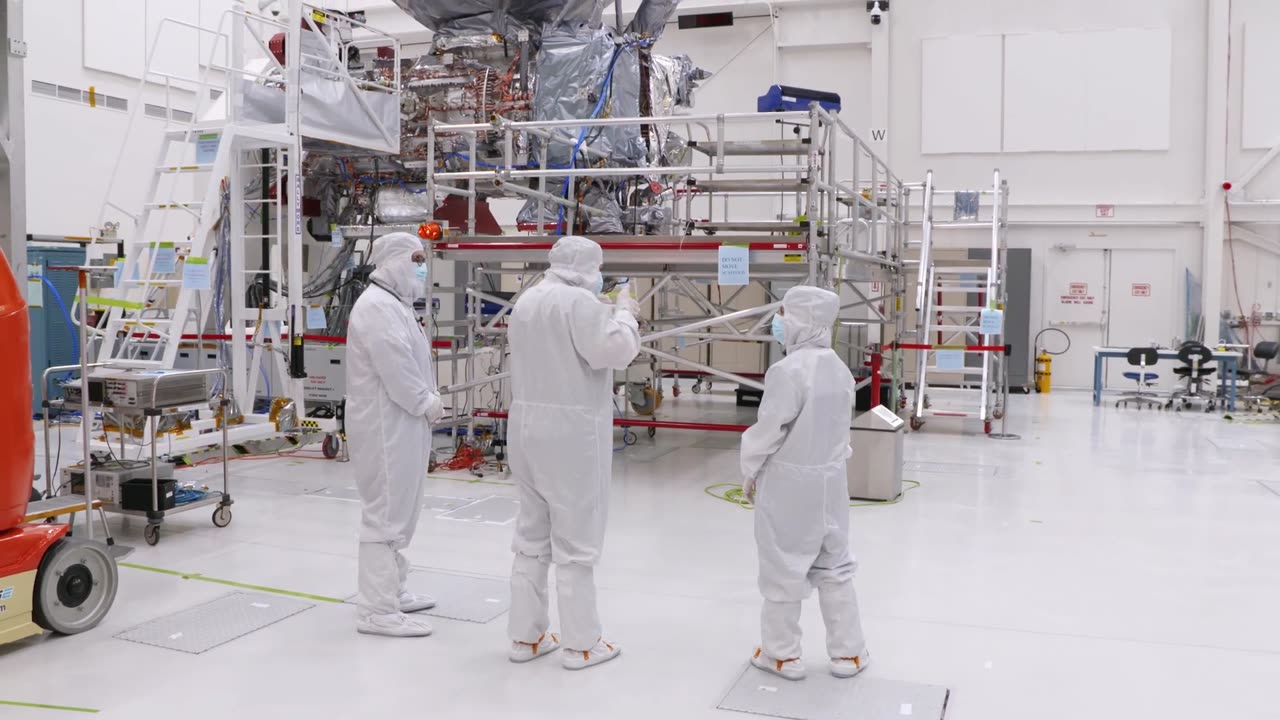Premium Only Content

Spacecraft Makers: Europa Clipper's Instrument Integration
#spacecraft #europaclippers #integration #spaceship #nasa #galaxies #spacerocket #rocket #aircraft #solarsystem #planets #wolfchamp
Spacecraft Makers: Europa Clipper's Instrument Integration
Hardware for NASA’s Europa Clipper spacecraft was developed at various institutions and facilities across the U.S. and Europe, including NASA's Jet Propulsion Laboratory. That work included the science instruments and other spacecraft components, such as the propulsion module, radio frequency module, solar arrays, electronics vault, and more.
During the assembly, test, and launch operations phase of the mission, engineers put together the spacecraft, test its various components, and prepare it for its launch and journey to Jupiter’s ice-encrusted moon Europa.
In this episode of the Spacecraft Makers video series, spacecraft assembly, test, and launch operations mechanical engineer Steve Barajas and science systems engineer Jenny Kampmeier provide a behind-the-scenes look at the nearly completed spacecraft in the High Bay 1 clean room at JPL.
The propulsion module for the spacecraft was built by the Johns Hopkins Applied Physics Laboratory (APL) in Laurel, Maryland, with help from NASA’s Goddard Space Flight Center in Greenbelt, Maryland, and JPL.
The science instruments were developed by APL, the School of Earth and Space Exploration at Arizona State University, Southwest Research Institute in San Antonio, JPL, UCLA, University of Michigan, University of Texas at Austin, and the Laboratory for Atmospheric and Space Physics at the University of Colorado Boulder.
Spacecraft Makers is a video series that takes audiences behind the scenes to learn more about how space missions, like Europa Clipper, come together. Europa Clipper will explore this icy moon of Jupiter to see if there are conditions suitable for life. The spacecraft needs to be hardy enough to survive a 1.6 billion-mile, six-year journey to Jupiter – and sophisticated enough to perform a detailed science investigation of Europa once it arrives at the Jupiter system in 2030.
Europa Clipper is expected to launch in October 2024 from Kennedy Space Center in Florida.
Spacecraft Makers: Europa Clipper's Instrument Integration
Hardware for NASA’s Europa Clipper spacecraft was developed at various institutions and facilities across the U.S. and Europe, including NASA's Jet Propulsion Laboratory. That work included the science instruments and other spacecraft components, such as the propulsion module, radio frequency module, solar arrays, electronics vault, and more.
During the assembly, test, and launch operations phase of the mission, engineers put together the spacecraft, test its various components, and prepare it for its launch and journey to Jupiter’s ice-encrusted moon Europa.
In this episode of the Spacecraft Makers video series, spacecraft assembly, test, and launch operations mechanical engineer Steve Barajas and science systems engineer Jenny Kampmeier provide a behind-the-scenes look at the nearly completed spacecraft in the High Bay 1 clean room at JPL.
The propulsion module for the spacecraft was built by the Johns Hopkins Applied Physics Laboratory (APL) in Laurel, Maryland, with help from NASA’s Goddard Space Flight Center in Greenbelt, Maryland, and JPL.
The science instruments were developed by APL, the School of Earth and Space Exploration at Arizona State University, Southwest Research Institute in San Antonio, JPL, UCLA, University of Michigan, University of Texas at Austin, and the Laboratory for Atmospheric and Space Physics at the University of Colorado Boulder.
Spacecraft Makers is a video series that takes audiences behind the scenes to learn more about how space missions, like Europa Clipper, come together. Europa Clipper will explore this icy moon of Jupiter to see if there are conditions suitable for life. The spacecraft needs to be hardy enough to survive a 1.6 billion-mile, six-year journey to Jupiter – and sophisticated enough to perform a detailed science investigation of Europa once it arrives at the Jupiter system in 2030.
Europa Clipper is expected to launch in October 2024 from Kennedy Space Center in Florida.
Spacecraft Makers: Europa Clipper's Instrument Integration
Hardware for NASA’s Europa Clipper spacecraft was developed at various institutions and facilities across the U.S. and Europe, including NASA's Jet Propulsion Laboratory. That work included the science instruments and other spacecraft components, such as the propulsion module, radio frequency module, solar arrays, electronics vault, and more.
During the assembly, test, and launch operations phase of the mission, engineers put together the spacecraft, test its various components, and prepare it for its launch and journey to Jupiter’s ice-encrusted moon Europa.
In this episode of the Spacecraft Makers video series, spacecraft assembly, test, and launch operations mechanical engineer Steve Barajas and science systems engineer Jenny Kampmeier provide a behind-the-scenes look at the nearly completed spacecraft in the High Bay 1 clean room at JPL.
The propulsion module for the spacecraft was built by the Johns Hopkins Applied Physics Laboratory (APL) in Laurel, Maryland, with help from NASA’s Goddard Space Flight Center in Greenbelt, Maryland, and JPL.
The science instruments were developed by APL, the School of Earth and Space Exploration at Arizona State University, Southwest Research Institute in San Antonio, JPL, UCLA, University of Michigan, University of Texas at Austin, and the Laboratory for Atmospheric and Space Physics at the University of Colorado Boulder.
Spacecraft Makers is a video series that takes audiences behind the scenes to learn more about how space missions, like Europa Clipper, come together. Europa Clipper will explore this icy moon of Jupiter to see if there are conditions suitable for life. The spacecraft needs to be hardy enough to survive a 1.6 billion-mile, six-year journey to Jupiter – and sophisticated enough to perform a detailed science investigation of Europa once it arrives at the Jupiter system in 2030.
Europa Clipper is expected to launch in October 2024 from Kennedy Space Center in Florida.
-
 LIVE
LIVE
FreshandFit
10 hours agoAfter Hours w/ Milo, Akademiks & Girls
13,644 watching -

Badlands Media
10 hours agoDevolution Power Hour Ep. 412 - Monroe Doctrine, Durham Rug, Income Taxes, and MORE!
64.9K9 -
 2:09:46
2:09:46
Inverted World Live
4 hours agoNASA Hints at Life Beyond Earth | Ep. 150
56.9K3 -
 19:01
19:01
Stephen Gardner
9 hours agoAlex Jones: ‘Trump Is About to Do Something MASSIVE!'
27.9K101 -
 LIVE
LIVE
Drew Hernandez
22 hours agoCANDACE OWENS ACCEPTS TPUSA INVITATION TO DISCUSS SUSPICION BEHIND CHARLIE KIRK ASSASSINATION?!
1,221 watching -
 2:52:10
2:52:10
TimcastIRL
5 hours agoDrunk Raccoon Becomes Top US Story After Getting Plastered, Passing Out In Bathroom | Timcast IRL
210K81 -
 LIVE
LIVE
SpartakusLIVE
7 hours agoRule #1 - The BEST Loot is ALWAYS in the OTHER GUY'S BAG
622 watching -
 2:16:27
2:16:27
ThatStarWarsGirl
4 hours agoTSWG LIVE: CHRISTMAS IS COMING! Stargate's BACK & DC is Doomed?!
16.9K3 -
 2:38:16
2:38:16
I_Came_With_Fire_Podcast
12 hours agoDid Pete Hegseth Commit WAR CRIMES | No more INCOME TAX | More Fraud in Minnesota W/ Mike Caldarisie
20K9 -
 1:32:30
1:32:30
Adam Does Movies
7 hours ago $0.55 earnedTalking Movies + Ask Me Anything - LIVE
16.5K1